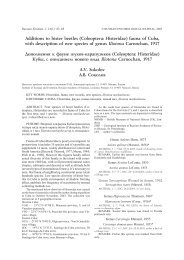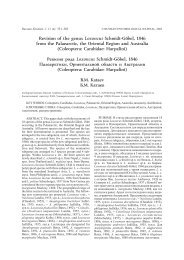Full PDF Version - KMK Scientific Press
Full PDF Version - KMK Scientific Press
Full PDF Version - KMK Scientific Press
You also want an ePaper? Increase the reach of your titles
YUMPU automatically turns print PDFs into web optimized ePapers that Google loves.
Russian Entomol. J. 11 (4): 331–333<br />
© RUSSIAN ENTOMOLOGICAL JOURNAL, 2002<br />
Taxonomical notes on the species of the genus Isotomurus<br />
(Collembola: Isotomidae) with the “balteatus”-like colouration<br />
Òàêñîíîìè÷åñêèå çàìåòêè ê âèäàì ðîäà Isotomurus<br />
(Collembola: Isotomidae) ñ îêðàñêîé òèïà “balteatus”<br />
M.B. Potapov*, E.V. Starostenko**<br />
Ì.Á. Ïîòàïîâ*, Å.Â. Ñòàðîñòåíêî**<br />
* Moscow State Pedagogical University, Kibalchicha str., 6, build.5, Moscow 129278 Russia.<br />
* Ìîñêîâñêèé ïåäàãîãè÷åñêèé ãîñóäàðñòâåííûé óíèâåðñèòåò, óë. Êèáàëü÷è÷à, 6, êîðï.5, Ìîñêâà 129278 Ðîññèÿ.<br />
**Donetsk National University, Shchorsa str., 46, Donetsk 83050 Ukraine.<br />
**Äîíåöêèé íàöèîíàëüíûé óíèâåðñèòåò, óë. Ùîðñà, 46, Äîíåöê 83050 Óêðàèíà.<br />
KEY WORDS: Collembola, Isotomidae, Isotomurus, steppe.<br />
ÊËÞ×ÅÂÛÅ ÑËÎÂÀ: Collembola, Isotomidae, Isotomurus, ñòåïü.<br />
ABSTRACT. Isotomurus stepposus sp.n. differring<br />
from other species by only one pair of trichobothria is<br />
described. Isotomurus balteatus with the similar colouration<br />
is shortly redescribed.<br />
ÐÅÇÞÌÅ. Îïèñûâàåòñÿ Isotomurus stepposus<br />
sp.n., îòëè÷àþùèéñÿ îò äðóãèõ âèäîâ íàëè÷èåì âñåãî<br />
îäíîé ïàðû òðèõîáîòðèé. Ïðèâîäèòñÿ êðàòêîå<br />
ïåðåîïèñàíèå Isotomurus balteatus, èìåþùåãî àíàëîãè÷íóþ<br />
îêðàñêó.<br />
Introduction<br />
Presently, Isotomurus Börner, 1903 is probably the<br />
most complicated genus of Isotomidae for the taxonomy,<br />
this is explained by considerable polychaetosis on all<br />
parts of body, the maximum jumping complex development<br />
in all species (furca is useless as a character), and<br />
common setae and sensilla weakly diverged (the description<br />
of sensillar chaetotaxy is difficult). The modern<br />
taxonomical revisions [Deharveng & Lek, 1993; Carapelli<br />
et al., 1995a, 1995b, 2001] have established the following<br />
1) many species do exist in this genus, which were<br />
proved by biochemical and ecological criteria 2) The only<br />
character to discriminate between the most species (especially<br />
in palustris complex) is a colouration — the<br />
pattern of distribution of pigment grains on body. The<br />
mentioned character is, however, unsuitable to work<br />
with because of its depending on fixation, age instar of<br />
a specimen, and possible strong intrapopulation variation.<br />
It was shown [Carapelli et al., 2001] that certain<br />
color pattern can appear parallely, for instance in “Isotomurus<br />
balteatus”. Available material on the species of<br />
the genus with the “balteatus”-like colouration (broad<br />
transversal bands in anterior parts of tergites) made it<br />
possible to describe a new species and fixed the position<br />
of I. balteatus s.str., which was never described before.<br />
Isotomurus stepposus sp.n.<br />
Figs 1–7.<br />
MATERIAL. Holotype ($, slide): Ukraine, Donetsk Area,<br />
“Kamennye Mogily” Reserve, slopes of ridges, south exposition,<br />
23.10.1996. leg. E. Starostenko.<br />
Paratypes. 4 $$ from the same locality (slide). Collected in<br />
June 1993 and May 1994. Type specimens are kept in Moscow<br />
State Pedagogical University.<br />
DESCRIPTION. Body length 1.3 mm (the description<br />
was compiled basing adult specimens). Colouration of „balteatus“<br />
type: with broad transversal bands on all segments of<br />
body (Fig. 1). In paler individuals the bands on Abd IV–VI<br />
lighter than on other segments. 8+8 ommatidia, G and H<br />
smaller. Postantennal organ narrow elliptical, more than 1.5<br />
times longer than diameter of ommatidium. Labrum 5,5,4,<br />
apical ridges high and sharp. Labium with 5–6+5–6 basomedian<br />
and 5+5 proximal setae (Fig. 3). 4–5+4–5 postlabial<br />
setae. Antennae with few thin and short sensilla, thick and<br />
short sensilla present, 4, 1, 2 in number on Ant I, II, III. On<br />
Ant. I they arranged as in I. rabili Deharveng & Lek, 1993 (see<br />
fig. 9 in first description of rabili). Claw without inner but<br />
lateral teeth, empodium without teeth. Apical bundle of<br />
tibiotarsi with 8.8.9 setae. Legs with weakly developed macrosetae,<br />
equal to 1.3–1.4 of inner length of claw of leg III.<br />
Ventral tube with 5–6+5–6 laterodistal and 8–10+8–10 anterior<br />
setae. Retinaculum with 2–5 setae. Furca with few setae<br />
(Figs 5, 6). Posterior side of dens usually with 30 setae. Mucro<br />
quadridentate, without lamella and seta, with curve projecting<br />
subapical tooth (Fig. 2). Sexual dimorphism udeveloped.<br />
Chaetotaxy. Macrosetae smooth. Sensilla as in gallicus:<br />
6,6/5,5,6,7,6 (s), 1–2 the most laterally positioned of which<br />
thickened, 2 medial sensilla of Abd V much longer than others<br />
(Fig. 7). Microsensilla: 1,1/1,1,1 (ms), on Abd I–II they in<br />
anterior-lateral position, on Abd III — slightly in front of prow.<br />
Trichobothria 0,0,1 on Abd. II, III, IV (Fig. 4).<br />
DIAGNOSIS. After many features (chaetotaxy of ventral<br />
tube, retinaculum and furca, colouration, body chaetotaxy)<br />
new species mostly closed to I. gallicus Carapelli et al., 2001<br />
(= I. balteatus sensu Poinsot) (S France) and differs in<br />
absence of trichobothria on Abd. III. Latter species have 0,1,1
332 M.B. Potapov, E.V. Starostenko<br />
Fig. 1. Habitus Isotomurus stepposus sp.n.<br />
Ðèñ. 1. Ãàáèòóñ Isotomurus stepposus sp.n.<br />
on Abd. II, III, IV. Poinsot-Balagauer & Ferard [1983]<br />
indicated trichobothria sometimes lacking on Abd.III in I.<br />
gallicus (i.e. formula was 0,0,1). Following modern taxonomy<br />
such a variability is hardly possible. Those specimens<br />
could probably be refer to our or closed species. After the<br />
number of trichobothria I. stepposus is in intermediate position<br />
between species with few trichobothria (gallicus, rabili) and a<br />
species has entirely lost them (antennalis Bagnall, 1940).<br />
DISTRIBUTION. Known only from the type locality.<br />
Isotomurus balteatus (Reuter, 1876)<br />
Fig. 9.<br />
Bas.: Isotoma balteata Reuter, 1876<br />
MATERIAL. 1) S Arkhangelsk Area, Velsk Distr., Ramen’e<br />
village, on moist stones in spring (together with I. stuxbergi<br />
(Tullberg, 1876)), august 1981; 2) Leningradskaya Area, Beloostrov<br />
station of Finnish railway, sphagnous pine wood, along the<br />
shores of ponds, august 2002.<br />
SHORT DESCRIPTION. Postantennal organ small, much<br />
smaller than diameter of ommatidium. Labium with many<br />
basomedian and proximal setae, ca. 10+10 in each group.<br />
Claw without inner but lateral tooth, empodium with small<br />
tooth. Apical bundle of tibiotarsi with many setae (more than<br />
10). All legs with long and ciliated macrosetae. Ventral tube<br />
with 15–20+15–20 laterodistal setae. Furca with numerous<br />
setae, as typical for the genus. Mucro quadridentate, with seta<br />
and lamella running to proximal tooth.<br />
Chaetotaxy. Macrosetae and other setae of body distinctly<br />
ciliated. 2 medial sensilla of Abd V only slightly longer than<br />
others (Fig. 9). Trichobothria 3,3,1 on Abd. II, III, IV. On<br />
Abd.III lateral trichobothria much shorter than others.<br />
DIAGNOSIS. For a long time all species with transversal<br />
banded pattern were referred to I. balteatus, which was recorded<br />
and redescribed almost all over the world. In Europe, it was<br />
shown that several species “hidden” within I .balteatus, subsequently,<br />
I. ghibellinus Carapelli et al., 1995 (palustris complex)<br />
and I. gallicus Carapelli et al., 2001 (gallicus group) were<br />
erected. Our specimens are in agreement with the first description,<br />
particulary in having mucronal seta, and were collected in<br />
areas closed to type locality (SE Finland). Isotomurus balteatus<br />
belong neither to palustris complex nor palustris group because<br />
of having mucronal seta, rather short medial sensilla on<br />
Abd.V, and many laterodistal setae on ventral tube.<br />
DISTRIBUTION: Uncertain. Known from SE Finland,<br />
Leningradskaya and Arkhangelsk Areas.<br />
Isotomurus ghibellinus Carapelli et al., 1995<br />
Fig. 9.<br />
MATERIAL. S Azerbaijan. Lenkoran. Ghirkansky Reserve.<br />
Along spring bank in oak forest. January 1983. leg. M. Potapov.<br />
ACKNOWLEDGEMENTS. This work was carried out<br />
with the support by the Russian Foundation for Fundamental<br />
Research (grant 02–04–49083) and <strong>Scientific</strong> schools program<br />
for Potapov M.<br />
References<br />
Carapelli A., Frati F., Fanciulli P. P. & Dallai R. 1995a. Genetic<br />
differentiation of six sympatric species of Isotomurus (Collembola,<br />
Isotomidae); is there any difference in their microhabitat<br />
preference? // Eur. J. Soil Biol. Vol.31. No.2. P.87–99.<br />
Carapelli A., Fanciulli P. P., Frati F. & Dallai R. 1995b. The use<br />
of genetic markers for the diagnosis of sibling species in the<br />
genus Isotomurus (Insecta, Collembola) // Boll. Zool.<br />
Vol.62. P.71–76.<br />
Carapelli A., Frati F., Fanciulli P. P. & Dallai R. 2001. Taxonomic<br />
revision of 14 south-western European species of Isotomurus<br />
(Collembola, Isotomidae), with description of four new<br />
species and the designation of the neotype for I. palustris //<br />
Zoologica Scripta. Vol.30. No.2. P.115–143.<br />
Deharveng L. & Lek S. 1993. Remarques sur la morphologie et<br />
la taxonomie du genre Isotomurus Börner, 1903 et description<br />
de deux espèces nouvelles de France (Collembola:<br />
Isotomidae) // Ann. Soc. Entomol. Fr. (N.S.). T.29. No.3.<br />
P.245–259.<br />
Poinsot-Balaguer N. & Ferard M. 1983. Contribution a l’étude du<br />
groupe Isotomurus palustris (Müller) (Collembole Isotomidae)<br />
redescription de Isotomurus balteatus (Reuter, 1876<br />
nov.comb.) // Nouv. Rev. Ent. T.13. No.2. P.147–156.
Notes on the species of Isotomurus with the “balteatus”-like colouration<br />
Figs 2–9. 2–6 — Isotomurus stepposus sp.n.: mucro laterally (2), labium (proximal setae marked) (3), chaetotaxy of Abd IV (only<br />
sockets shown in common setae, sensilla connected by dotted line) (4), manubrium anteriorely (5), dens posteriorely (6); 7–9 —<br />
medial sensilla s1 and s2 of p-row on Abd.V in I. stepposus sp.n. (7), I. ghibellinus (8) and I. balteatus (9).<br />
Ðèñ. 2–9. 2–6 — Isotomurus stepposus sp.n.: ìóêðî ñáîêó (2), ëàáèóì (ïðîêñèìàëüíûå õåòû îáâåäåíû) (3), õåòîòàêñèÿ Abd<br />
IV (ó îáû÷íûõ õåò ïîêàçàíû ëèøü îñíîâàíèÿ, ñåíñèëëû ñîåäèíåíû òî÷å÷íîé ëèíèåé) (4), ìàíóáðèé ñïåðåäè (5), äåíñ ñçàäè (6);<br />
7–9 — ìåäèàëüíûå ñåíñèëëû s1 è s2 p-ðÿäà íà Abd V ó I. stepposus sp.n. (7), I. ghibellinus (8) è I. balteatus (9).<br />
333












